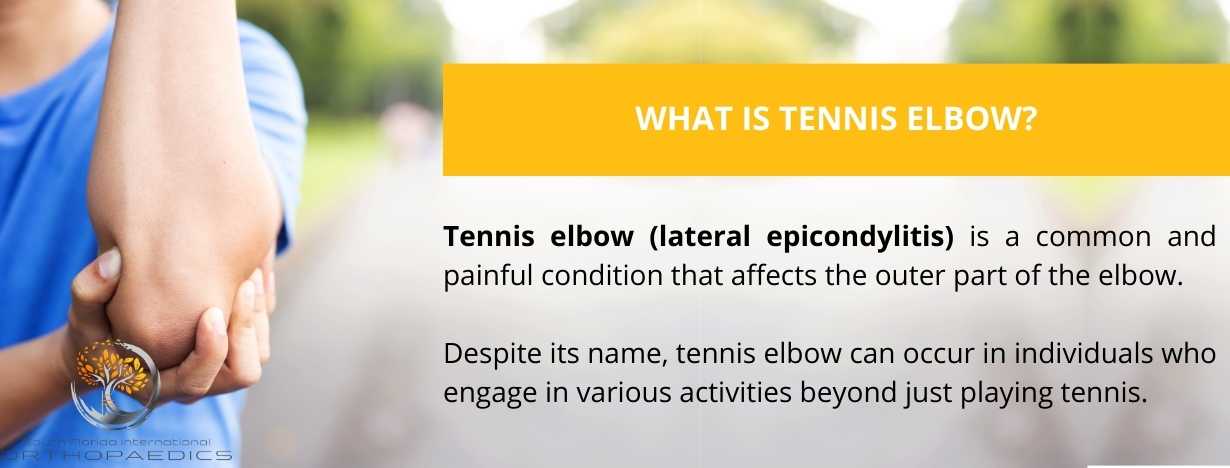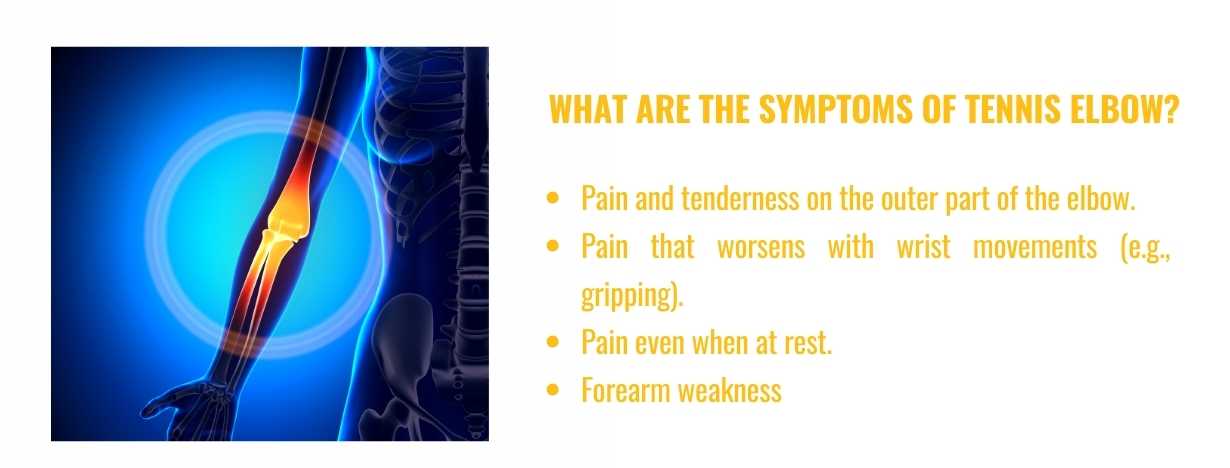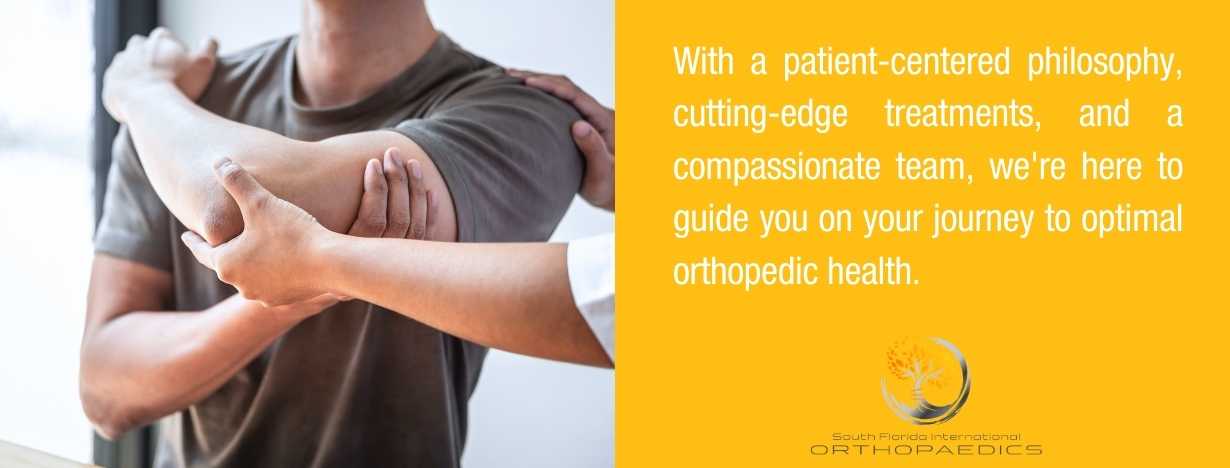Tennis elbow, medically known as lateral epicondylitis, is a condition that often affects individuals who engage in repetitive arm motions. It is the most common cause of elbow pain that affects about 1-3% of the general population.

Whether you’re an athlete, a professional, or simply someone who uses their arms frequently, understanding the causes, recognizing the symptoms, and knowing the most effective treatments for tennis elbow is essential.
In this comprehensive guide, we’ll delve into the key aspects of this condition to empower you with knowledge and strategies for managing it effectively.
What causes tennis elbow?
Tennis elbow (lateral epicondylitis) is a common and painful condition that affects the outer part of the elbow. Despite its name, tennis elbow can occur in individuals who engage in various activities beyond just playing tennis.
Tennis elbow is primarily caused by overuse and repetitive strain on the forearm muscles and tendons. The repeated contraction of these muscles, especially during gripping, lifting, and wrist movements, can lead to tiny tears in the tendons over time.
While the exact mechanisms behind these micro-tears are not fully understood, they are thought to result from a combination of factors, including:
Repetitive activities
Engaging in activities that involve frequent and forceful gripping, such as playing tennis, using hand tools, typing, painting, or even cooking, can contribute to the development of tennis elbow.
Improper technique
Incorrect form or technique during physical activities can place excessive stress on the tendons, increasing the risk of injury. For instance, using an improper backhand stroke in tennis can strain the forearm tendons.
Age and degeneration
As we age, the tendons naturally become less flexible and more prone to injury. The repeated stress from repetitive motions can exacerbate this degeneration, increasing the likelihood of tennis elbow.
Muscle imbalances
Weakness or imbalances in the forearm muscles can lead to increased stress on certain tendons, making them more susceptible to injury.
Lifestyle factors
Factors such as smoking, obesity, and poor overall physical conditioning can weaken the body’s ability to repair and maintain healthy tendons.
What are the symptoms of tennis elbow?
How do you know if you have tennis elbow? Look out for telltale signs such as pain and tenderness on the outer part of the elbow. This discomfort may radiate down the forearm and worsen when gripping objects or performing activities involving wrist movement.
Other symptoms include forearm weakness, difficulty fully extending the arm, and pain even when at rest.
How is tennis elbow diagnosed?
If you suspect tennis elbow, consulting a medical professional is crucial for an accurate diagnosis. Physicians often rely on physical examinations and may conduct specific tests to pinpoint the condition. This includes:
-
Grip test
One common diagnostic test for tennis elbow is the grip test. You might be asked to grip an object, such as a tennis racket or a handgrip dynamometer, to gauge your grip strength and identify any weaknesses or pain.
-
Resisted wrist extension test
During this test, you’ll be asked to extend your wrist against resistance. Pain or discomfort on the outer part of the elbow during this movement can indicate tennis elbow.
While imaging studies are not always necessary for diagnosing tennis elbow, they can be helpful in ruling out other potential causes and assessing the severity of the condition.
X-rays or magnetic resonance imaging (MRI) scans may be ordered to visualize the bones, soft tissues, and tendons around the elbow.

Once a diagnosis of tennis elbow is confirmed, your physician will work with you to develop a personalized treatment plan based on the severity of your symptoms, your medical history, and your individual needs.
Early diagnosis and appropriate management are key to effectively addressing tennis elbow and minimizing its impact on daily activities.
How do doctors treat tennis elbow?
Tennis elbow can be a challenging condition to manage. Fortunately, combining conservative treatments and therapies can effectively alleviate pain, promote healing, and restore functionality. This includes the following:
1. Rest and activity modification
Give your arm the rest it needs by avoiding activities that exacerbate the pain. Modify your movements to reduce strain on the affected area.
2. Ice and compression
Applying ice and compression techniques can help alleviate inflammation and relieve pain. Remember to avoid using ice directly to the skin.
3. Physical therapy
A cornerstone of tennis elbow recovery is engaging in specific exercises to strengthen the forearm muscles and improve flexibility. A skilled physical therapist can guide you through a tailored program.
4. Bracing and supports
A forearm strap or brace can help alleviate pressure on the affected tendons and provide support during activities.
5. Medications
Tennis elbow can be accompanied by discomfort and pain. In addition to rest, physical therapy, and other treatments, medications can play a role in managing the symptoms and promoting healing. Some examples of drugs include:
- Oral NSAIDs (ibuprofen, naproxen)
- Topical NSAIDs
- Acetaminophen
- Prescription medications like stronger pain relievers or muscle relaxants to manage severe pain and discomfort.
It’s crucial to consult a doctor before using these medications.
6. Corticosteroid injections
In some cases, corticosteroid injections may be recommended to reduce inflammation and provide short-term relief. However, these injections are generally limited in frequency due to potential side effects.
7. Platelet-rich plasma therapy
This emerging treatment involves injecting a concentrated solution of platelets from your own blood into the affected area. PRP may aid in tissue healing and regeneration.
8. Long-term management and lifestyle adjustments
Once you’ve recovered from tennis elbow, it’s essential to adopt lasting lifestyle adjustments to prevent recurrence.
Gradually reintroduce activities, focusing on proper form and technique. Regular exercise, including stretching and strength training, can help maintain forearm health and prevent future issues.
When is surgery necessary for tennis elbow?
In rare cases when conservative treatments fail to provide relief, surgical intervention might be considered. Your physician might opt for an invasive procedure if:
- There is severe pain and disability that affects an individual’s everyday life.
- It has become a chronic condition.
- There is tendon tear and degeneration.
- Tennis elbow recurrence.
Surgery aims to remove damaged tissue, alleviate pressure on the affected tendons, and promote healing from tennis elbow.
Your doctor may choose between two common surgical approaches: open surgery or arthroscopic surgery. However, they will thoroughly assess your condition first before recommending this option.
Where to find the best shoulder specialist in Miami?

South Florida International Orthopaedics is your trusted destination for comprehensive and specialized treatment, including tennis elbow and a wide range of orthopedic conditions affecting the shoulder, such as:
We are committed to delivering exceptional care that empowers you to live life to the fullest. With a patient-centered philosophy, cutting-edge treatments, and a compassionate team, we’re here to guide you on your journey to optimal orthopedic health. We treat all kinds of musculoskeletal conditions, from the most complex to the most common, including sports medicine.
Contact our experienced South Florida Orthopedics via a contact form or call our Miami office (305) 233-0011 or the Homestead office (305) 247-1701 for a consultation.
Take the first step towards a pain-free, active, and fulfilling lifestyle!
The material contained on this site is for informational purposes only and DOES NOT CONSTITUTE THE PROVIDING OF MEDICAL ADVICE, and is not intended to be a substitute for independent professional medical judgment, advice, diagnosis, or treatment. Always seek the advice of your physician or other qualified healthcare providers with any questions or concerns you may have regarding your health.
